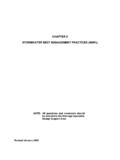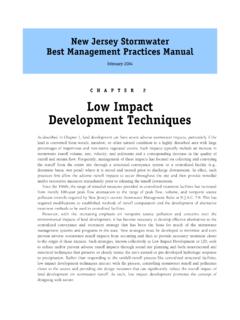Transcription of Stormwater Best Management Practice (BMP) …
1 Stormwater best Management Practice (BMP). Selection and Implementation January, 2003. Stormwater BMP Selection and Implementation Midwest Research Institute Funding for this program was made possible through a Section 319 Nonpoint Source Management Program grant from the U. S. Environmental Protection Agency through a contract with the Stormwater /Nonpoint Source Management Section of the Florida Department of Environmental Protection, the Florida Community College Consortium for Pollution Prevention Education and Midwest Research Institute. Stormwater BMP Selection and Implementation Table of Contents Table of Contents Introduction .. 1. Construction Site best Management practices Summary Chart .. 5. Construction Site best Management practices Details .. 8. 1 Temporary Gravel 8. 2 Construction Road 10. 3 Coagulant / Water Treatment Polyacrylamide (PAM) .. 12. 4 Temporary Sediment Basin .. 15. 5 Temporary Sediment Trap .. 19. 6 Silt Fence.
2 21. 7 Storm Drain Inlet 24. 8 Temporary Fill Diversions .. 28. 9 Diversion 29. 10 Temporary Slope Drain .. 31. 11 Temporary Check 33. 12 Dewatering .. 35. 13 Floating Turbidity Barrier .. 37. 14 Tree Preservation and Protection .. 39. 15 Temporary Seeding / Sodding / Mulching .. 41. 16 Vegetative Streambank Stabilization .. 43. Permanent Stormwater best Management practices Summary Chart .. 45. Permanent Stormwater best Management practices Details .. 49. 17 Wet Detention Basins .. 49. 18 Retention/Infiltration Basins .. 52. 19 Infiltration / Exfiltration Trenches .. 54. 20 Grassed Waterways & 56. 21 Landscape Retention (Bio-Retention) .. 58. 22 Underdrains and Stormwater Filter 59. 23 Stormwater Conveyance 61. 24 Diversion .. 63. 25 Level Spreader .. 65. 26 Check Dam .. 66. 27 Waterway Drop 68. i Stormwater BMP Selection and Implementation Table of Contents Table of Contents (continued). 28 Outlet Protection .. 70. 29 Riprap .. 71. 30 Porous Pavement.
3 72. 31 Concrete Grid and Modular Pavement .. 74. 32 Paved Flume .. 76. 33 Cellular Concrete Block .. 77. 34 Grid Confinement Systems .. 79. 35 Baffle 81. 36 Liquid / Solid Separators .. 83. 37 Surface Roughening .. 85. 38 Trees / Shrubs / Vines and Ground Covers .. 87. Housekeeping best Management practices Summary Chart .. 90. Housekeeping best Management practices Details .. 91. 39 Fertilizer Management .. 91. 40 Litter 94. 41 Catch Basin Cleaning .. 95. 42 Street 96. References .. 97. ii Stormwater BMP Selection and Implementation Introduction Introduction Florida's rapid population growth and our subsequent change in land use have created a need for effective Stormwater Management . Florida's clean water supply is critical for our drinking, our agriculture, our industry and our recreation. As Stormwater reaches the Florida ground, it runs off the land and flows into wetlands, lakes, rivers and the sea, it infiltrates through the soil to the groundwater, or it is used by plants and returned to the atmosphere through evaporation.
4 As land is changed from its natural state to farm use or to urban development, the earth is compacted and/or paved. In this compacted condition, land can no longer absorb our fifty to sixty-five inches of annual rainfall and run-off becomes a Stormwater Management problem. Stormwater pollution is the largest source of water quality degradation in the state of Florida. Urbanization affects the quantity of Stormwater causing an increase in runoff and an acceleration of runoff flow (peak discharge rate). For example, in land's natural state there is approximately 10% runoff, 50% infiltration, and 40%. evaporation, but in a highly developed area there is approximately 55% runoff, 15% infiltration, and 30% evaporation. This increase in volume and velocity of runoff causes more frequent flooding, drastic changes in natural stream channels, erosion of stream banks, and damage to structures and vegetation. In addition to hydrological affects of Stormwater runoff, the pollution of our waterways is another critical effect from Stormwater Management systems.
5 When land is developed, there is a disruption in the natural, physical, chemical and biological processes that interact to recycle most materials found in Stormwater . Increased human land use results in an increase in leaves, litter, animal wastes, oil, greases, heavy metals, fertilizers, and pesticides carried in Stormwater runoff. Page 1. Stormwater BMP Selection and Implementation Introduction This creates high pollutant loading of: Suspended Solids Includes sediment and decayed plant material that clogs waterways, smother bottom-living aquatic organisms, and increase turbidity Oxygen Demanding Consume oxygen in the water, which may Substances lead to fish kills Nutrients Such as nitrogen & phosphorus that cause unwanted and uncontrolled growth of algae and aquatic weeds Pathogenic Bacteria Can contaminate lakes and shellfish waters to prevent swimming and harvesting Heavy Metals Such as lead, cadmium, chromium, copper, and zinc that can disrupt the reproduction of fish and shellfish and accumulate in fish tissues Oil and Grease Toxic to many aquatic organisms Excessive Fresh Changes the salinity of estuaries and there- Water fore alters the types of organisms able to live in this critical nursery area The goals of Florida's Stormwater Management system are to provide flood protection, maintain or improve water quality, control erosion and sedimentation, and.
6 As much as possible, allow for recreation facilities, open spaces, aesthetics, and Stormwater reuse. Florida was the first state in the country to implement a comprehensive Stormwater Management system in 1979 to help meet the goals stated above. The Florida Stormwater Management program has been and continues to be reviewed, updated, and improved to this present time. A recent change has been the permit streamline legislation, which requires an environmental resource Page 2. Stormwater BMP Selection and Implementation Introduction permit (ERP) from the appropriate water Management district for any proposed land use changes. This permitting aids in determining new/changed land use affects on Stormwater quality, Stormwater quantity and wetland impact. Permits are granted based on demonstrating the ability to meet a set of three performance standards and use of best Management practices (BMPs) to achieve those standards. These standards are comprised of insuring that: 1) the peak discharge rate, 2) the volume and 3) the pollution load of Stormwater leaving a site after development are no greater than before development.
7 A best Management Practice (BMP) is defined as: a control technique used for a given set of conditions to achieve water quality and quantity at a minimum price.. BMPs are implemented during construction and development of a new area and are operational after development. BMPs can be nonstructural to improve Stormwater quality by reducing the generation of runoff and the generation and accumulation of potential Stormwater pollutants at or near their sources ( , wetlands protection, fertilizer control, street cleaning, etc.) or structural used to control Stormwater volume and peak discharge in addition to reducing the magnitude of pollutants ( , vegetation, swales, retention basins, etc.). BMPs should be combined together to make up a BMP treatment train . This term describes a Stormwater Management system in which the individual BMPs are the cars making up the train . the more BMPs incorporated into the system, the better the performance of the treatment train.
8 On-line BMPs are those that temporarily store all of the runoff from a storm before discharging to surface waters. Off-line BMPs divert the treatment volume (typically the first inch of runoff) of polluted Stormwater for treatment and isolate it from the remaining Stormwater . Page 3. Stormwater BMP Selection and Implementation Introduction While we get about 120 storms a year, nearly 90% of them have less than one inch of rainfall. By capturing the first one inch of runoff, up to 90% of the pollution can be treated. Off- line BMPs should be used for all infiltration systems, and for most types of filter systems. Carefully selected and implemented best Management practices can effectively maintain or improve Florida's water quality. There are numerous BMPs that can be used during all phases of development. These phases include: 1. Erosion and sediment control during construction throughout the period of site development 2. Permanent Stormwater Management BMPs to treat the Stormwater after site development is completed.
9 3. Housekeeping to reduce pollutants in the finished Stormwater Management system This manual provides an overview of the most effective BMPs for each of these three phases. Preceding each section (Construction BMPs, Permanent Stormwater BMPs, and Housekeeping BMPs) is a summary chart that provides a quick comparative reference regarding the cost, effectiveness, maintenance requirements, etc. of each BMP. Details for each BMP are then provided to address planning, design, construction, and maintenance considerations. Further details about BMP implementation and associated Florida Department of Environmental Protection (DEP) guidelines can be found in The Florida Development Manual: A Guide to Sound Land and Water Management published by the Florida DEP in 1988 and in The Stormwater , Erosion, and Sedimentation Control Inspector's Manual published by the Florida DEP in 1999. Page 4. Stormwater BMP Selection and Implementation Construction Site BMPs Summary Chart Construction Site best Management practices Summary Chart Considerations Effectiveness Maintenance Conjunction with Other Required?
10 Pollutants Special Target Use in BMPs Cost BMP. High, with 1 Temporary Gravel Entrance Low proper Sediment Frequent Washrack None Yes maintenance Appropriate Initially 2 Construction Road Stabilization High Sediment Medium Stormwater None Recommended High system Sediment Coagulants / Water Treatment 3 Low High Sediment Low Basins, None Recommended Polymers Seeding Medium, Must dispose Appropriate for Moderate, Diversions, 4 Temporary Sediment Basin High Sediment except heavy of sediment large (>5. 70% Seeding for cleanout periodically acres) areas High for Medium, Must dispose Recommended 5 Temporary Sediment Trap Med course - med. Sediment except heavy Diversions of sediment for small areas particles for cleanout periodically Frequent Must dispose 6 Silt Fence Low Moderate Sediment monitoring As needed of sediment Yes required periodically High for Temp. ponding As many as May cause 7 Storm Drain Inlet Protection Low coarse Sediment Low must not be possible flooding particles only safety hazard Page 5.






